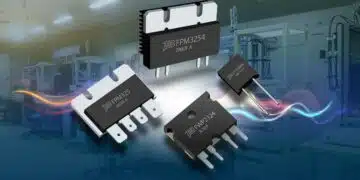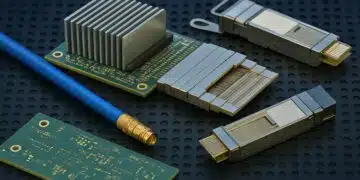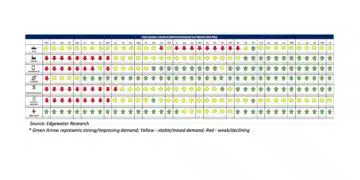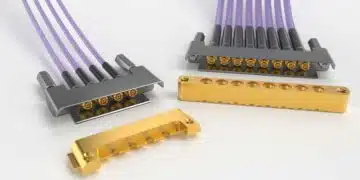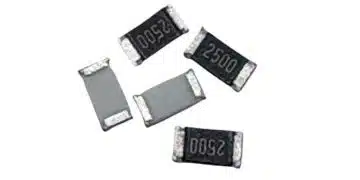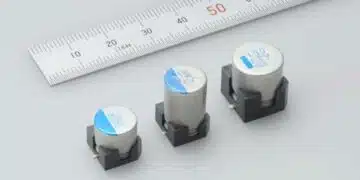Samsung Electro-Mechanics has developed three types MLCCs for automotive powertrains and two types fpr the anti-lock brake system (ABS) in a bid to target the market for value-added automotive products.
- Developed 5 types of MLCCs for automotive powertrains and ABS
- Achieved industry-leading capacity by applying proprietary materials and techniques
- Gearing to target the automotive market with the full lineup of automotive MLCCs
The MLCC for powertrain requires high technical complexity because it must handle high-capacity in a high-temperature and high-pressure environment inside the vehicle’s powertrain. Samsung Electro-Mechanics has succeeded in developing a total of three types: 2012 size (2.0 X 1.2mm) 1.0uF (microfarad: a unit of capacitance), 3216 size (3.2 X 1.6mm) 2.2uF, and 3225 size (3.2 X 2.5mm) 4.7uF.
Samsung Electro-Mechanics explained that its proprietary application of ceramic and electrode materials and an ultra-precision lamination method enabled the highest electric capacity for each size and that the components can be stably used even at high voltages of up to 100V (volts). The company added that the existing 12V(volts) automotive electrical system has recently been changed to a high voltage of 48V(volts), so its MLCCs can be widely applied to markets that require high voltage products such as automotive batteries as well as industrial devices including 5G networks and solar power.
Samsung Electro-Mechanics also developed two types of MLCCs for the anti-lock brake system (ABS). As automotive ABS is a component directly related to safety, it must ensure a high level of reliability. Two types of MLCCs for ABS developed by Samsung Electro-Mechanics (2012 (2.0 X 1.2mm) 4.7uF and 2.2uF) increased the lifespan by 20% and product stability (DC-BIAS characteristic: As the applied DC voltage increases, the product’s capacitance decreases) by 5% compared to existing products. In addition, the withstand voltage (the highest voltage that the product can withstand without being damaged by voltage) is also 1.5 times higher than that of other products so that the components can stably function in extreme environments.
“Development and mass production of automotive MLCCs require complex technology,” said Doo-Young Kim, Vice President of Component Business Division at Samsung Electro-Mechanics.” We have built a full lineup of automotive MLCCs, including those for powertrains, which require a particularly high level of technical complexity. Samsung Electro-Mechanics is planning to strengthen its product competitiveness and responsiveness to customers by applying distinctive materials and process technologies.”
Samsung Electro-Mechanics has developed and produced MLCCs since 1988 and has the world’s second-largest market share in the IT sector. The company has stepped up the production of automotive MLCCs since 2016 by establishing a dedicated production line in Busan in 2018, followed by the construction of a new automotive MLCC factory in Tianjin, China.
Samsung Electro-Mechanics has reinforced its lineup of value-added automotive products that can withstand high temperatures, high pressure with high reliability based on its technological prowess in the ultra-small and ultra-high-capacity MLCC sector and has expanded MLCC supplies to global auto parts and automakers.
※ Reference
Automotive MLCCs play similar roles to MLCCs for IT, but their use environment is different from IT products, and above all, they require a high level of reliability and durability since they are closely related to human life.
Automotive MLCCs must operate stably even in extreme environments, such as high temperatures (above 150℃), low temperatures (minus 55℃), and high humidity (85% or higher humidity), with a tensile strength against external impact. In addition, only the products that passed the rigorous manufacturing criteria of AEC-Q200 (certification for passive automotive components), which is a reliability test standard for automotive electronic components, as well as thorough verification required by each client can be supplied.
At least 3,000 to 15,000 MLCCs are installed in an automobile, and the unit cost is higher than that of IT products. Automotive MLCCs are also considered as a blue ocean by the industry as the related market is expanding with the increased use of electronic components, electric vehicles, and autonomous vehicles.
The global MLCC market is expected to grow from the current KRW 16 trillion to KRW 20 trillion in 2024. Automotive MLCCs, which account for 29% of the global MLCC market this year, is projected to increase to about 35% by 2024. (Source of market data: Reports from Kiwoom Securities and Eugene Investment & Securities)


